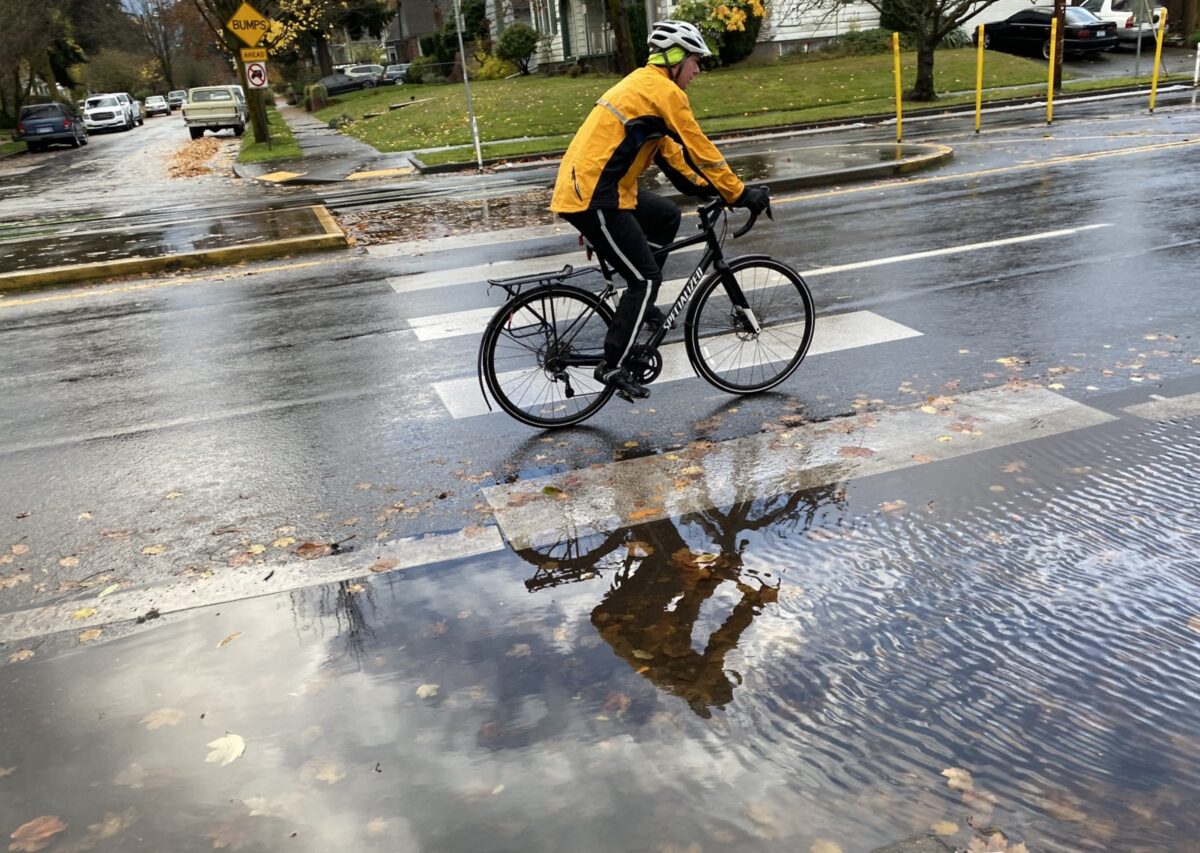
(Photos: Jonathan Maus/BikePortland)
Riding through leaves and standing water is part of the Great Portland Bicycling Experience. Since many of you might be new to this cycling thing (welcome, we’re glad you’re here!), I figured it was time to share a few tips and ask some of our more experienced readers to chime in with their advice.
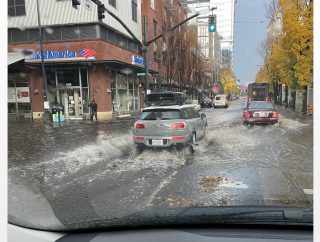
(Photo sent in by a reader)
Before we go any further, remember you can report hazardous conditions like standing water and really bad leaf piles in bike lanes directly to the Portland Bureau of Transportation at (503) 823-1700 (for urgent issues) or 823-SAFE (non-urgent – see more maintenance contact info here).
What type of hazards am I talking about? The photo above is what I refer to as Lake Michigan. It’s a massive puddle that forms in the bike lane on North Rosa Parks Way at Michigan every year. From a hazard perspective, it’s no joke. It’s so deep and daunting in size that bike riders leave the bike lane and go around it. This introduces the potential for mishaps with other road users. Combined with darker skies this time of year and the ever-anxious mood of drivers these days, this de facto bike lane closure is a serious thing.
I wish PBOT would keep bike lanes cleaner. Heck, they even bought a special bike-lane-sized sweeper years ago! But the reality is they never keep up with this type of maintenance, so it’s up to us. If you have time and inclination, I recommend doing what you can to prevent standing water by clearing drains and/or calling them into PBOT.
If you find yourself faced with pedaling through a big puddle, you have two options:
- Go around: Check behind you and then avoid the puddle altogether. I do this if I can’t assess the depth of the puddle or if my hunch tells me it’s not worth trying.
- Slow down and roll through: Reducing speed will keep the spray from messing up your bike or your clothes. It will also let you take last-second evasive actions if necessary.
Advertisement
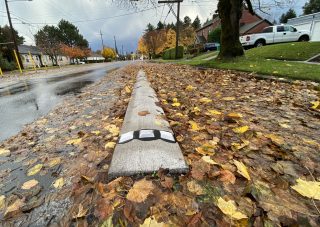
Leaves are an entirely different animal. There’s a chemical reaction that happens when leaves get wet and start to decompose. I’m not a scientist but I can tell you that the outcome of this reaction is excessive slipperiness. Leaves claim many victims every year. Everyone thinks they can outsmart them, but leaves always get the last laugh.
As with standing water, the best course of action is to ride around leaves. But if you can’t, here are a few ways to not fall:
- Slow down before you get to them — especially in corners.
- Rule of thumb: The darker and wetter leaves are, the slippery they’ll be. Bright and crisp leaves are generally safer.
- Once you’re on the leaves, use brakes sparingly. If you are turning, don’t touch your brakes or you will slip out!
- Even acceleration is dicey in leaves. If you’re on an e-bike and have gotten used to higher speeds, you should be extra careful.
- What you can’t see can hurt you: Leaves can cover rocks and other road debris that can cause major damage to you or your bike. If you can’t see what’s under the leaves, don’t ride through them.
- You’ll be more sure-footed with wider tires and lower tire pressure.
- Remember, you have the legal right to leave the bikeway at any time to avoid leaves (and other hazards).
Anything else you want to know about riding this time of year? Ask me.
And my esteemed BikePortland Brain Trust, what else should folks know about staying safe in these conditions?
— Jonathan Maus: (503) 706-8804, @jonathan_maus on Twitter and jonathan@bikeportland.org
— Get our headlines delivered to your inbox.
— Support this independent community media outlet with a one-time contribution or monthly subscription.

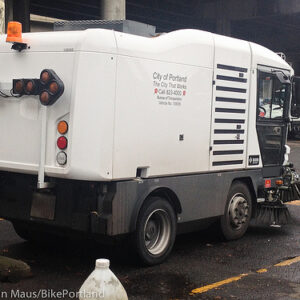
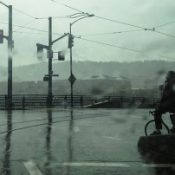
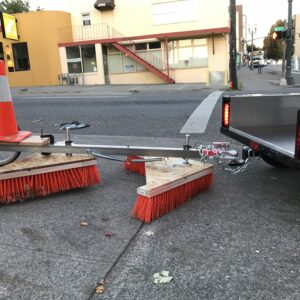

Thanks for reading.
BikePortland has served this community with independent community journalism since 2005. We rely on subscriptions from readers like you to survive. Your financial support is vital in keeping this valuable resource alive and well.
Please subscribe today to strengthen and expand our work.
A few years ago I was riding on 7th near the bluff by Sellwood Park. Leaf removal had just occurred and apparently a piece of equipment had a hydraulic fluid leak and I fell on a turn. If you see a sheen on the pavement know the traction is like wet ice.
It’s one of the biggest issues I have with protected lanes, as well as MUPs. Without continued political support and funds for upkeep they are very susceptible to trash/leaf buildup and neglect. Or active expropriation by adjacent properties’ trashcans, cars, etc.
That being said, it’s very rare to see any type of street cleaning in Portland. Perhaps it’s due to the naturally high rain frequency, they hope most stuff is washed away?
I don’t know if it’s changed, but SF used to sweep most areas twice a month or more. I felt it was a bit of a pretense for ticket revenue and to discourage long term parked cars. But they did get cleaned a lot more than Portland.
From the PBOT site: “Due to declining revenue and funding cuts, all curbed residential streets get swept only 1-2 times per year. All major arterials get swept 6-8 times per year.”
One of my pet peeves is that in the protected lanes on Rosa Parks, some residents still rake their leaves into piles in the bike lane. Not fun to run into a 4ft tall pile of leaves in the dead of night, especially when you can’t swerve around it because you’re curbed in on both sides.
“Due to declining revenues and funding cuts…” appears to be America’s swan song. Americans want everything but don’t want to pay for it. And Moody’s Analytics says to expect declining state revenues over the next decade which will force some states (Florida, Louisiana, Nevada for instance) to simply shut down. In Oregon, PERS vs. corporate tax cuts will be the Big Kahuna. In Portland, there’s the money wasted on a bloated, do-nothing police force.
And, then there’s the small print on PBOT’s form for reporting hazardous street conditions: Don’t expect a follow-up.
Naito is NOT better. There is proof. The driving lane has been clear all week. The “other” zone is a mess full of leaves, branches and those bollards that will never actually make anyone safer. Oh, those scary cars. Right…
Crossing the Hawthorne bridge was quite exciting today. At least there is basically nobody out there.
The USS Oregon Mast Memorial Monument in Tom McCall Waterfront Park has had a chain link fence put around it, maybe to protect it from protesters-? Not only does the fence and its footing sit right on top of the pedestrian lane of Better Naito, but they pushed all the leaves into a big high pile in the northbound bike lane.
You know, I lived and biked everywhere in Portland for 18 years and never really had any significant issues with leaves – true, it was always bad for a certain time of the year, but as soon as it snowed, the leftover gravel became a much bigger issue, then the broken glass, the right-hooks, the nasty drivers…
Of all the hazards of biking in Portland, the leaves are the most beautiful.
Oops – I just up-voted your post by mistake. The leaves on the trees are beautiful; the wet leaves on the pavement not so much. It’s nice that you have fond memories of Portland, but you obviously don’t live here anymore b/c otherwise you’d know that we’ve had a ton of rain over the last couple of weeks – in the 5- to 10-inch range – just as the leaves are coming down. The combination is the worst I’ve seen in my entire time in Portland. Many bike lanes – and even many less-trafficked streets – are like a hockey rink right now: thick mats of leaves covered with slimy water. It’s a serious problem and I’m glad JM is highlighting it.
Right? Let’s hear from anyone who has actually seen PBOT’s bike lane sweeper in use! Tell us about your sighting. Were was it? When was it? We need to do a Missing Sweeper Report.
The bike lane sized street sweeper sounds cool. The city would have more money to operate it if so much money wasn’t going to deal with the rioters and clean up after the homeless. Oh well. Portland was “the city that works” ,now it’s the “THE CITY THAT ENABLES”.
One of my routes on Division westbound around 65th tends to collect large quantities of fir cones. Another hazard to add to the list. Most of the bike lane puddles on outer Division are truly unavoidable. Go slow and hope you can see the curb to judge how deep the puddle is.
Can we post pictures of Portland on this site? If so, how?
Hi Jeff. No. We don’t allow pictures to be posted by commenters. However I’ll consider doing it for you if you share the URL to the image.
Worth mentioning here: if you live near one of these puddles/lakes, you can help! These often occur because leaves clog the storm drain covers. You can use a pole or longer shovel to clear the drains if you start noticing a backup.
If you clear a clogged drain, you will be rewarded with a very satisfying sluuurp as the water starts to drain rapidly.
JM, I wish you would do a Big Exposé on street cleaning in Portland. Who in city gov’t is responsible for doing it? How often – and how – do they do it? What equipment do they use? How big is the crew? (are two guys responsible for all of Portland?) Is the work contracted out? Why does sweeping seem to happen only at night? (it’s not like Portland has a big traffic problem during the day).
I saw a comment recently about Ryan, who is possibly a manager of the street-sweeping operation. Many of us have had interactions with Ryan over the years and could speak to our own challenges with trying to get our streets and bike lanes cleaned.
And what about the many, many homeowners and landscaping businesses who blow and rake leaves directly into the streets and especially the bike lanes? We all see it all the time. Is it legal? If not, whom can we report it to? Or does no one care?
Okay – obviously I have too much time on the bike to think about this stuff. If you’ve done stories about this issue, we’d love to have the links. Thanks.
When I attended PBOT budget meetings (for 7 awful years), we often heard about street cleaning. Apparently the sewer department (BES) is PBOT’s biggest client financially, up to a third of the transportation budget, to clean and maintain storm sewers. If I remember correctly, BES doesn’t like to have leaves washed into the storm sewers, the reasons being that not only do leaves clog up the sewer works downstream, but the acid from the decaying leaves damages the infrastructure. BES would prefer that the leaves clog the sewer grates and slow the flow of water into the storm pipes (and the sumps in East Portland). They would also like to see a vast expansion of the bioswale network throughout the city, but that takes lots of land and money, especially in already built up areas. So leaving the leaves and puddles on the street is the next best thing, at least for BES.
My understanding is that most street sweeping in Portland is done at night – for reasons that have never been clear to me.
The only thing worse than wet leaves is frozen leaves! Be extra super careful if the temp drops below freezing Friday night (last I checked, it said low 32 F). I crashed while turning across a pile of frozen leaves a few years ago. Thank goodness the driver behind me was paying attention/had good reflexes and did not run me over.
The last twelve years or so that I lived in Portland, I used a front studded tire all winter. Really good to have on the often-frosty descent into Beaverton. And on the front, the extra rolling resistance isn’t really that big of a deal.
But I would always put it on in November, usually long before any frosts or snows. Why? Wet, decomposing leaves. The studs punch right through! Really, a studded tire is THE solution to this problem. I can’t guarantee they’ll never let go in a really deep, slick leaf pile, but the difference is absolutely night and day. Really made all the difference on slick, leafy descents down Terwilliger, Montgomery, etc.
Now, I know my advice here on studded tires always gets pushback (“what a waste of money! it like, hardly ever, snows here!” … year after year), even from people with $3000 bikes. But I’m making my annual pitch anyway. A good studded tire costs about $75, and for anything that you’ll run into in Portland other than a full-on ice storm, one is all you need. Much cheaper than x-raying that broken clavicle or separated shoulder.
Great idea. If you’re going to ride in ice or snow even once, I say the $75 is worth it. I’ve seen so many wipeouts over the years.
Doesn’t a studded bike tire make for a hellish, bumpy ride? I have enough trouble keeping my momentum when I hit regular bumps on the street.
When riding on snow and ice, your options are studded tires or years of pain pooping through a broken pelvis. Your choice.
Not really. There is no loss of traction on bare wet pavement, and the ride is not rougher. Just a little noisier.
When using studded tyres, use rubber cement on the rims (only one side); this will prevent the slippage. Also prior to mounting the clincher, use puncture-proofing liner (if not any used tube with the valve snipped off will do).
The most important thing that I learned commuting from Raleigh Hills to NW is: get better brakes! Whatever worked for you in the Summer will need to be twice as effective in the Winter. V-brakes, cantis, something. Remember, your braking surface is now worms and diesel oil, not aluminum.
You must be talking about rim-grabbing brakes. I got disc brakes some years ago and will never go back. Disc brakes are mandatory in Portland’s wet weather, I think.
Yes. I did have disc wheels and brakes on my gravel bike, but removed them, got a new fork and went back to V-Brakes. Long story, but I did not like the wheels that came with the bike and the extra weight, so it made sense to switch. I live in Bend, so not a big issue, but if I still commuted in Portland, I’m sure I would think differently.
I live on Rosa Parks and have seen the sweeper at least three times this fall. It’s there, doing its thing, just like the trees with their falling leaves.
Wooden bridges freeze and become hazardous at temps even close to freezing. Fanno creek bridge took me out hard on a morning when nothing else had frost!
Ove been telling people this for the past few years, but since I’m not in any bike communities it’s fallen on deaf ears. We need to buy our own bike path street sweepers. Have a training day set up monthly and have volunteers drive them. I bet cyclists would love to do the work, while I hate to say it I’ve always gotten the vibe city workers see us as a burden. I ride through downtown for work on weekends around 6:30am and i always see street sweepers. Just about every week I see them as I ride south on 5th street.
A downside would be the opponents who might say “Oh, wow once again rich, entitled, cyclists get their way” we’ll im not rich, I’m a minority who likes to bike, and I never see anyone who looks like me. ALSO I’m being selfish and thinking about the Rosa Parks/Vancouver/Williams corridor, but each neighborhood can do fundraisers and buy one. Train people. Get volunteers out every 3 days or so.
When people say stuff like that, it’s usually just a slightly more refined way of dismissing people, and saying “I don’t care about you or your perspective; mine is the only one that matters!!!” It just serves to divide our already small community. I mean… why should bike riders be “opponents” of other bike riders?
My post was a word vomit. What I meant there was, that’s was non-bike riders would say. You know the same people who claim we don’t need protected bike lanes, also think green paint will Make a car stay in their lane.
A lot of cyclists also say this if you mention wanting to improve anywhere but East Portland or (in selected contexts) SW.
And by “a lot” I really mean a few, because I’ve found most riders to be pretty reasonable folks.